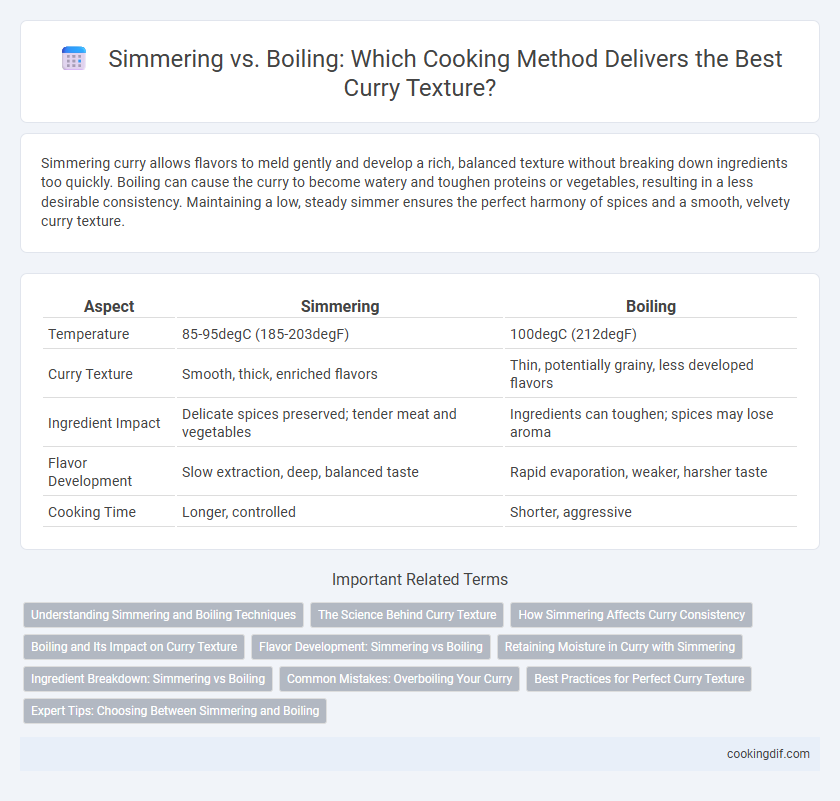Simmering curry allows flavors to meld gently and develop a rich, balanced texture without breaking down ingredients too quickly. Boiling can cause the curry to become watery and toughen proteins or vegetables, resulting in a less desirable consistency. Maintaining a low, steady simmer ensures the perfect harmony of spices and a smooth, velvety curry texture.
Table of Comparison
| Aspect | Simmering | Boiling |
|---|---|---|
| Temperature | 85-95degC (185-203degF) | 100degC (212degF) |
| Curry Texture | Smooth, thick, enriched flavors | Thin, potentially grainy, less developed flavors |
| Ingredient Impact | Delicate spices preserved; tender meat and vegetables | Ingredients can toughen; spices may lose aroma |
| Flavor Development | Slow extraction, deep, balanced taste | Rapid evaporation, weaker, harsher taste |
| Cooking Time | Longer, controlled | Shorter, aggressive |
Understanding Simmering and Boiling Techniques
Simmering curry involves cooking at a low temperature where small bubbles gently rise, allowing flavors to meld and the sauce to thicken without breaking apart ingredients, resulting in a smooth, rich texture. Boiling, with rapid, vigorous bubbles, can cause delicate spices and vegetables to lose their nuances and produce a thinner, less balanced curry. Mastery of simmering ensures optimal flavor extraction and a harmonious, velvety consistency essential for authentic curry dishes.
The Science Behind Curry Texture
Simmering curry allows the flavors to meld gently while proteins and vegetables tenderize without breaking down, preserving a smooth and rich texture. Boiling causes aggressive agitation, which can lead to curdling of dairy components and separation of oils, resulting in a grainy or greasy consistency. Controlling temperature to maintain a gentle simmer is essential for achieving the ideal viscous and creamy texture characteristic of authentic curries.
How Simmering Affects Curry Consistency
Simmering curry gently breaks down ingredients, allowing flavors to meld and thicken the sauce without overcooking or causing separation. This slow cooking process helps achieve a smooth, velvety texture by reducing excess liquid and concentrating spices. Unlike boiling, simmering maintains the integrity of delicate spices and prevents the curry from becoming watery or too thin.
Boiling and Its Impact on Curry Texture
Boiling curry results in a more aggressive heat that rapidly breaks down ingredients, which can lead to a thinner, less cohesive sauce with diminished flavor depth. The high temperature causes proteins and vegetables to lose their structural integrity quickly, often resulting in a mushy texture rather than the desired tender consistency. For a richer, thicker curry texture, maintaining a gentle simmer is generally preferred over vigorous boiling.
Flavor Development: Simmering vs Boiling
Simmering curry allows flavors to meld gently, enhancing depth and complexity by slowly breaking down spices and ingredients without harsh evaporation. Boiling, on the other hand, can cause volatile aromatics to dissipate quickly, resulting in a flatter, less nuanced taste. Maintaining a steady simmer preserves essential oils and subtle layers of flavor critical to authentic curry texture and richness.
Retaining Moisture in Curry with Simmering
Simmering curry gently at a low temperature allows flavors to meld while preserving the dish's moisture, preventing the sauce from drying out. Unlike boiling, which can cause rapid evaporation and toughen meat or vegetables, simmering ensures a tender texture and rich consistency. Maintaining a steady simmer retains essential juices, enhancing the curry's depth and overall mouthfeel.
Ingredient Breakdown: Simmering vs Boiling
Simmering curry allows gradual ingredient breakdown, preserving texture and enhancing flavor integration, while boiling accelerates disintegration, potentially leading to mushy vegetables and overcooked proteins. Controlled simmering maintains the integrity of spices and herbs, ensuring balanced taste and consistency. Boiling can cause rapid water evaporation and uneven ingredient softening, impacting the overall curry texture negatively.
Common Mistakes: Overboiling Your Curry
Overboiling curry often results in a loss of delicate flavors and a tough, grainy texture as the intense heat breaks down essential spices and ingredients. Simmering allows the curry to develop depth and complexity by gently melding flavors without evaporating too much liquid. Maintaining a low, steady simmer prevents over-reduction and helps preserve the ideal creamy consistency crucial for authentic curry texture.
Best Practices for Perfect Curry Texture
Simmering curry at a low, steady temperature allows flavors to meld deeply and results in a rich, velvety texture by gently breaking down ingredients without overcooking. Boiling causes rapid cooking that can toughen meat and vegetables while making the sauce watery and separating oils. Maintaining a consistent simmer ensures optimal thickness and enhances the curry's overall mouthfeel and depth of flavor.
Expert Tips: Choosing Between Simmering and Boiling
Simmering curry preserves the delicate blend of spices and prevents the sauce from becoming too thin, resulting in a richer, more concentrated flavor and velvety texture. Boiling can cause the ingredients to break down too quickly, leading to a watery consistency and loss of aromatic nuances crucial for authentic curry. Expert chefs recommend maintaining a gentle simmer to achieve optimal thickness and depth, especially for slow-cooked curry recipes like Indian butter chicken or Thai green curry.
Simmering vs Boiling for curry texture Infographic

 cookingdif.com
cookingdif.com